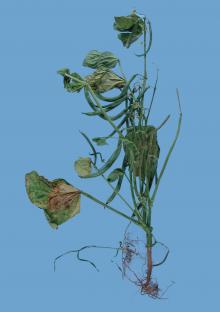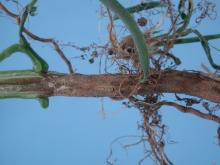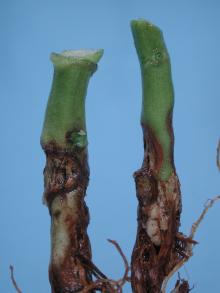Cause The fungus, Rhizoctonia solani (sexual stage: Thanatephorus cucumeris), causes root rot of many plant species. It overwinters in soil or plant debris and can survive many years as sclerotia or chlamydospores. Moderate temperatures (less than 70°F) are favorable for disease development. Seedlings are quite susceptible to Rhizoctonia.
Symptoms Sunken, reddish-brown lesions are found on roots or the hypocotyl and may cause stunting or plant death. When the hypocotyl is girdled on young plants, damping-off may occur.
Cultural control
- Plant resistant varieties if available.
- Sow beans when temperatures are warmer.
- Sow seed at a shallow depth.
- Avoid planting beans after a sugar beet crop that had crown rot problems.
Chemical control
- Blocker 4F (Group 14) at 2 to 3 pints/A at planting. Do not feed treated vines to livestock. 12-hr reentry.
- Quadris Flowable (Group 11) at 0.4 to 0.8 fl oz/1000 row feet applied in a 7-inch or less band either in furrow at planting or as a directed spray at cultivation. 4-hr reentry.
Biological control
- Amplitude ST at 2 to 8 fl oz/100 seeds. Preharvest interval is 0 days. 4-hr reentry. O
- Bexfond at 7 to 14 fl oz/A. 4-hr reentry. O
- Stargus at 6 to 8 fl oz per 1,000 ft row as an in-furrow treatment. Preharvest interval is 0 days. 4-hr reentry. O




